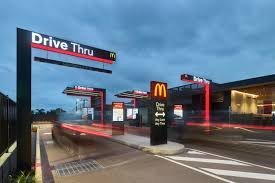
Revolutionizing Convenience: Drive-Thru Systems in Saudi Arabia
In the fast-paced world of today, convenience is king. Nowhere is this more evident than in Saudi Arabia, where the quick-service restaurant (QSR) industry has embraced innovative solutions to meet the demands of a tech-savvy, time-conscious population. Among these innovations, Drive-Thru Systems have emerged as a cornerstone of modern dining, transforming how businesses deliver speed, efficiency, and customer satisfaction. This blog post explores the evolution, impact, and future of Drive-Thru Systems in Saudi Arabia, highlighting their role in reshaping the QSR landscape and aligning with the Kingdom’s ambitious Vision 2030 goals.
With urbanization, technological advancements, and a growing preference for on-the-go dining, drive-thru systems have become integral to Saudi Arabia’s food and beverage sector. From bustling cities like Riyadh and Jeddah to emerging hubs like Dammam and Al-Khobar, these systems are redefining convenience for millions. This article dives deep into the components, benefits, and cultural significance of drive-thru systems, offering insights into how they are revolutionizing the customer experience in the Kingdom.
Drive-Thru System: The Backbone of Quick-Service Efficiency
A Drive-Thru System is a service model that allows customers to order, pay, and receive their food or services without leaving their vehicles. Popularized by global fast-food giants like McDonald’s and KFC, drive-thru systems have evolved beyond traditional setups to incorporate advanced technologies such as digital menu boards, AI-driven order-taking, and contactless payment solutions. These systems are designed to maximize speed, accuracy, and convenience, making them ideal for Saudi Arabia’s fast-paced urban environments.
The core components of a modern drive-thru system include:
-
Speaker Posts: Equipped with high-quality audio technology, speaker posts enable clear, two-way communication between customers and staff. In Saudi Arabia, these systems often support multiple languages, including Arabic and English, to cater to the Kingdom’s diverse population.
-
Digital Menu Boards: Bright, interactive displays showcase menus with high-resolution graphics, making it easy for customers to browse and order. These boards can be updated remotely, allowing restaurants to adjust offerings based on demand or promotions.
-
Drive-Thru Headsets: These facilitate seamless communication between order-takers and kitchen staff, reducing wait times and ensuring order accuracy.
-
Vehicle Detection Systems: Sensors detect approaching vehicles, streamlining the ordering process and minimizing delays.
-
Contactless Payment Systems: In response to post-COVID preferences, many drive-thrus now offer mobile and card-based payment options for a hygienic and efficient experience.
The integration of these elements creates a seamless customer journey, from placing an order to driving away with a meal in minutes. In Saudi Arabia, where 60% of QSR sales come from drive-thru and delivery channels, these systems are not just a convenience but a business necessity.
Drive-Thru System in Saudi Arabia: A Cultural and Economic Fit
The rise of Drive-Thru Systems in Saudi Arabia is deeply tied to the Kingdom’s cultural and economic landscape. With a young, tech-savvy population and a rapidly urbanizing society, the demand for quick and convenient dining options has skyrocketed. According to industry insights, the QSR sector in Saudi Arabia is thriving, driven by a growing middle class and a preference for fast-paced lifestyles. Drive-thru systems align perfectly with these trends, offering a solution that caters to both local traditions and modern expectations.
Cultural Adaptation
Saudi Arabia’s unique cultural context has shaped the adoption of drive-thru systems. For instance, menus often feature traditional dishes like shawarma and kebabs alongside international fast-food offerings to appeal to local tastes. Additionally, drive-thru systems respect cultural norms by providing a private and efficient way to order, which is particularly valued in a society where privacy is a priority. The inclusion of multilingual support, such as Arabic and English, ensures accessibility for the Kingdom’s diverse population, including expatriates and tourists.
Economic Alignment with Vision 2030
Saudi Arabia’s Vision 2030 initiative aims to diversify the economy, promote technological innovation, and enhance public services. Drive-thru systems contribute to these goals by fostering innovation and sustainability. For example, advanced drive-thru solutions reduce energy consumption through optimized ordering processes and support eco-friendly practices like digital receipts, aligning with Vision 2030’s sustainability objectives. In cities like Riyadh and Al-Khobar, where traffic congestion is a challenge, these systems minimize vehicle idling, reducing emissions and supporting environmental goals.
Urbanization and Consumer Preferences
Saudi Arabia’s rapid urbanization has led to a surge in QSRs, particularly in major cities like Jeddah, Riyadh, and Dammam. The convenience of drive-thru systems caters to the fast-paced lifestyles of urban dwellers, who value speed and efficiency. Additionally, the post-COVID demand for contactless services has accelerated the adoption of drive-thru solutions, as they minimize physical interactions while maintaining service quality.
The Evolution of Drive-Thru Technology in Saudi Arabia
The drive-thru landscape in Saudi Arabia has evolved significantly, driven by technological advancements and changing consumer expectations. Early drive-thru systems relied on basic speaker posts and static menu boards, but today’s solutions are powered by cutting-edge technologies that enhance efficiency and customer satisfaction.
AI-Powered Ordering
Artificial Intelligence (AI) is transforming drive-thru systems by automating order-taking and personalizing customer interactions. AI-driven voice recognition technology can process orders in multiple languages and dialects, reducing errors and speeding up service. In Saudi Arabia, where linguistic diversity is common, AI ensures accurate communication, even during peak hours. Moreover, AI systems can analyze customer data to suggest personalized menu items, boosting sales and enhancing the dining experience. For example, during Ramadan, AI can recommend popular iftar items, aligning with cultural preferences.
Digital Menu Boards and Real-Time Updates
Outdoor digital menu boards are a game-changer for QSRs in Saudi Arabia. These boards use high-resolution graphics and videos to attract customers and can be updated remotely to reflect promotions or menu changes. In a competitive market, this flexibility allows businesses to stay agile and responsive to consumer trends. For instance, a QSR in Jeddah can quickly update its menu to highlight seasonal offerings, ensuring relevance and appeal.
Contactless Payments and Mobile Integration
The integration of contactless payment systems has been a significant driver of drive-thru adoption in Saudi Arabia. Customers can pay via mobile apps, NFC-enabled cards, or digital wallets, ensuring a hygienic and efficient transaction. This is particularly important in the post-COVID era, where safety remains a priority. Additionally, mobile ordering apps allow customers to place orders in advance, further reducing wait times.
Vehicle Detection and Order Tracking
Advanced vehicle detection systems use sensors to identify approaching cars, triggering the ordering process and reducing delays. Real-time order tracking ensures that staff can prepare orders efficiently, minimizing errors and improving service speed. These technologies are particularly valuable in high-traffic cities like Riyadh, where long drive-thru lines are common during peak hours.
Benefits of Drive-Thru Systems for Businesses and Customers
Drive-thru systems offer a win-win for both QSRs and customers in Saudi Arabia. By streamlining operations and enhancing the customer experience, these systems drive revenue and loyalty.
For Businesses
-
Increased Efficiency: Drive-thru systems allow QSRs to serve more customers in less time, boosting revenue. AI and real-time tracking optimize workflows, ensuring smooth operations even during peak hours.
-
Cost Savings: Automated systems reduce the need for manual order-taking, lowering labor costs. Additionally, predictive analytics help manage inventory, preventing overstocking or shortages.
-
Data Insights: Drive-thru systems provide valuable data on customer preferences, peak hours, and order accuracy. QSRs can use this data to refine menus, optimize staffing, and improve service quality.
-
Competitive Edge: In a crowded QSR market, offering a fast and seamless drive-thru experience sets businesses apart, attracting tech-savvy consumers.
For Customers
-
Convenience: Drive-thrus allow customers to enjoy meals without leaving their vehicles, saving time and effort.
-
Safety: Contactless payments and minimal physical interaction align with post-COVID health preferences.
-
Personalization: AI-driven systems offer tailored recommendations, enhancing the dining experience.
-
Accessibility: Multilingual support and cultural menu adaptations make drive-thrus inclusive for all customers.
Challenges and Solutions in Implementing Drive-Thru Systems
While drive-thru systems offer numerous benefits, their implementation in Saudi Arabia comes with challenges. Addressing these requires strategic planning and investment.
Challenges
-
High Infrastructure Costs: Setting up a drive-thru system involves significant investment in equipment, such as speaker posts, digital menu boards, and vehicle detection systems.
-
Traffic Management: In busy cities like Riyadh, managing drive-thru traffic can be challenging, especially during peak hours.
-
Cultural Adaptation: Ensuring that drive-thru systems align with local preferences, such as offering halal options and accommodating family-oriented dining, is critical.
-
Staff Training: Employees need comprehensive training to operate advanced drive-thru technologies effectively.
Solutions
-
Modular Systems: Businesses can opt for scalable, modular drive-thru solutions to manage costs. For example, starting with a single-lane system and upgrading to multi-lane setups as demand grows.
-
Smart Layouts: Designing efficient drive-thru lanes with clear signage and multiple entry points can reduce congestion.
-
Cultural Customization: Incorporating traditional menu items and multilingual support ensures inclusivity and customer satisfaction.
-
Training Programs: Comprehensive staff training, supported by local providers, ensures smooth operations and minimizes errors.
The Future of Drive-Thru Systems in Saudi Arabia
The future of drive-thru systems in Saudi Arabia is bright, with emerging trends poised to further transform the QSR industry. As the Kingdom continues its journey toward becoming a global economic hub, drive-thrus will play a pivotal role in various sectors, from food and beverage to healthcare and banking.
Emerging Trends
-
AI and IoT Integration: The use of Artificial Intelligence and the Internet of Things (IoT) will enhance order accuracy and operational efficiency. For example, IoT-enabled sensors can monitor equipment performance, reducing downtime.
-
Sustainability Initiatives: Eco-friendly drive-thru solutions, such as energy-efficient kiosks and paperless systems, will align with Vision 2030’s sustainability goals.
-
Expansion Beyond QSRs: Pharmacies, banks, and retailers are adopting drive-thru systems for prescription pickups, financial transactions, and e-commerce order collections, broadening the scope of this technology.
-
Personalized Experiences: Leveraging data analytics, drive-thrus will offer tailored customer interactions, such as recommending items based on past orders or cultural preferences.
Alignment with Vision 2030
Drive-thru systems support Saudi Arabia’s Vision 2030 by promoting technological innovation, economic diversification, and sustainability. By reducing energy consumption and emissions, these systems contribute to environmental goals. Additionally, their role in enhancing customer experiences aligns with the Kingdom’s focus on improving public services and quality of life.
Conclusion
Drive-Thru Systems in Saudi Arabia are more than just a convenience—they are a testament to the Kingdom’s commitment to innovation and customer-centric solutions. By blending advanced technology with cultural sensitivity, these systems are transforming the QSR industry and beyond, offering speed, efficiency, and personalization. As Saudi Arabia continues to urbanize and embrace digital transformation, drive-thru systems will remain at the forefront of the service industry, driving progress and prosperity in line with Vision 2030.
From AI-powered ordering to sustainable practices, the evolution of drive-thru systems reflects the Kingdom’s dynamic and forward-thinking spirit. For businesses, investing in these systems is a strategic move to stay competitive in a thriving market. For customers, drive-thrus offer unparalleled convenience, making everyday interactions faster and more enjoyable. As the Kingdom looks to the future, drive-thru systems will continue to redefine convenience, one order at a time.
FAQs
-
What is a drive-thru system, and how does it work in Saudi Arabia?
A drive-thru system allows customers to order, pay, and receive goods or services without leaving their vehicles. In Saudi Arabia, these systems use advanced technologies like digital menu boards, AI-powered ordering, and contactless payments to provide a seamless experience tailored to local preferences. -
How do drive-thru systems support Saudi Arabia’s Vision 2030?
Drive-thru systems align with Vision 2030 by promoting technological innovation, economic diversification, and sustainability. They reduce energy consumption, minimize emissions, and enhance customer experiences, contributing to the Kingdom’s goals for a modern, diversified economy. -
What challenges do businesses face when implementing drive-thru systems in Saudi Arabia?
Challenges include high infrastructure costs, traffic management in busy cities, cultural adaptation, and staff training. Solutions involve scalable systems, smart layouts, culturally relevant menus, and comprehensive training programs. -
How does AI enhance drive-thru systems in Saudi Arabia?
AI improves drive-thru systems by automating order-taking, reducing wait times, and personalizing customer interactions. It supports multiple languages, suggests menu items based on preferences, and optimizes operations during peak hours. -
Are drive-thru systems only used in fast-food restaurants in Saudi Arabia?
No, drive-thru systems are expanding beyond QSRs to pharmacies, banks, and retail stores. They are used for prescription pickups, financial transactions, and e-commerce order collections, offering convenience across various sectors.







